Bhutan
Overview and Transformation of Education in Bhutan

Bhutan School
Bhutan’s current education system does not meet the needs of students and employers, only contributing to growing youth unemployment. Most Bhutanese students tend to see education as a way to obtain jobs in the public sector, which cannot accommodate them all.
School curricula should emphasize more skills-based training as well as critical thinking, creativity, innovation, communication, and leadership skills sought after by private sector employers. Bhutan’s current education system does not meet the needs of students and employers, only contributing to growing youth unemployment. Most Bhutanese students tend to see education as a way to obtain jobs in the public sector, which cannot accommodate them all. School curricula should emphasize more skills-based training as well as critical thinking, creativity, innovation, communication, and leadership skills sought after by private sector employers.
Overview and transformation of education in Bhutan
Modern education in Bhutan began as early as 1907, with records revealing how the first king of Bhutan ordered his chamberlain to contact two educationists[1], who sent over two teachers to start the first modern school at Haa in 1914. It proved difficult in the beginning to convince the public to send their children to school, with reference to accounts of parents hiding their children in barns or attics to keep them from getting enrolled. Prior to modern education, monastic education was the only form of learning, and it was considered a matter of pride and status in society to have a family member in a monastic institution.
The modern formal education system has since flourished in the country; it started off with an Indian curriculum that evolved in the 1980s to a contextualized curriculum with its own examination board, national teaching force and a university, the Royal University of Bhutan, which was established in 2003. As of 2021, there are 605 schools with 168324 students that employ 9902 teachers[2] with an education expenditure that amounts to 5.33% of the country’s GDP in 2018/ 19[3]. The medium of instruction in school is English, resulting in most of Bhutan’s literate youth being fluent and conversant in the language. The Bhutanese education system now takes three forms: a general formal education, monastic education and non-formal education, with the first being predominant.
For the small landlocked nation of Bhutan, modern education is the key to improve lives and bring change and prosperity for its people; the data is also indicative of a growing enrolment trend, with a gross enrollment rate of 93.51% at the primary, 75.26% at the secondary and 25.11% at the tertiary level (which includes Bhutanese studying abroad) in 2021. The nation provides 11 years of free basic education from classes PP to class X, with scholarships offered since 2019 to all class X graduates for Class XI in government and private schools[4], thereby improving their access to tertiary education.
With a general literacy rate of 71.4%[5], the modern form of education has been accepted as a great equalizer, responsible for lifting less advantaged sections of society out of poverty and improving their chances for success in adulthood. However, the current education system has also been the subject of scrutiny for failing to equip citizens for the 21st century; youth need adaptable competencies to thrive in newer dynamic job markets. The current school curricula do not emphasize skills-based training and focus little on developing critical thinking, innovation, creativity, communication and leadership skills, leaving many stranded and undesirable for jobs in the private and corporate sectors, which are the two main sources of employment outside the public sector.
These issues became more pronounced with the COVID-19 pandemic‘s disruption of the education system; schools were closed, with children trapped at home and isolated in distant communities and classroom teaching made defunct. The Ministry of Education (as the nodal agency for education), had neither planned nor prepared for such an emergency; with the help of donor agencies, in the midst of the pandemic, it began to develop a COVID-19 response plan that included protocols for the safe reopening of schools in a phased manner; it made adjustments to the curriculum content and delivery modalities and arranged for psycho-social support to address mental health issues in affected children. For the first time in Bhutan, lessons were delivered with the use of remote and online methods, through Google Classroom and TV. Additional self-instruction materials were developed to support children that did not have access to TV or the internet.
With the country already late to the digitization of learning, the introduction of online classes brought with it a host of accessibility issues to the fore, some that spoke of the emerging social and class divides; the costs of internet data, smartphones or owning a TV, etc. could not be borne by some parents, with others being far outside internet-access zones. This situation was compounded by both teachers and students suddenly having to familiarize themselves with online classes. The advantages of online classes have been touted numerous times, but it took the Bhutanese (as it did others) a fair amount of practice and acceptance to ensure immersion in virtual learning.
The catalyzing effects of COVID-19 meant that these shortcomings were felt deeply by the people of Bhutan and recognised by the highest authority in the country. The King of Bhutan issued a decree to reform the education sector, among others, recognising that the current education system needs to find relevance in current times:
“More than a hundred years later, we find ourselves on the cusp of a new century again and in need of a new vision to prepare for what lies ahead. Unlike the past century, this one is qualitatively and quantitatively different. It is defined by the accelerated rate of change in all aspects of our lives because of rapid technological advancements and globalisation. The future will be more wired and digital, driven by sophisticated technologies in towns and villages alike, as well as in homes and in workplaces. “ – the King of Bhutan.
It became evident that Bhutan’s current education system has not taken into account rapid technological advancement, failing to meet the needs of the individual as well as those of the country, thus actively contributing to youth unemployment.
Most Bhutanese students tend to see education as a means to obtain jobs in the public sector, which cannot accommodate them all.
It becomes obvious that school curricula should emphasize more skills-based training as well as critical thinking, creativity, innovation, communication and leadership skills, abilities sought after by private sector employers.
[1] Dr. Sutherland and Dr. John Graham in Kalimpong; The Growth and Development of Modern Education in Bhutan, Ratna Paul.
[2] Retrieved from www.education.gov.bt on December 4, 2022.
[3] Annual Education Statistics 2021, Pg. 4.
[4] Ministry of Education, Annual Education Statistics 2021, Pg. 7.
[5] Retrieved from www.nsb.gov.bt on December 4, 2022.
